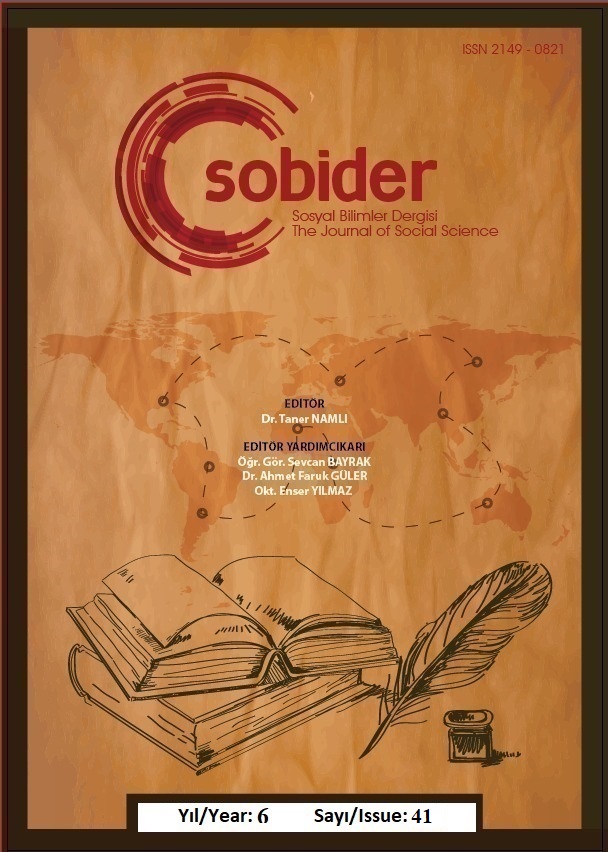Author :
Abstract
Roma İmparatoru Julius Casear M.Ö. 47 yılında Zile’de, Pontus Kralı II. Pharnakes’i mağlup etmiş ve böylece Anadolu topraklarında bin yıl sürecek Roma hâkimiyeti önündeki en önemli engeli bertaraf etmiştir. Sezar’ın “Veni, Vidi, Vici” sözleri ile hafızamıza kazınan ve Anadolu’nun tarihinde bir kırılma olarak kabul edilebilecek bu savaşın önemini takdir eden bazı seyyahlar ve araştırmacılar Zile’ye gelerek savaş yerinin tespiti hususunda incelemeler yapmışlardır. Buna rağmen savaşın yapıldığı nokta bugün dahi bir muamma olarak kalmıştır. Öte yandan antik dönemde cereyan eden, özellikle büyük tarihi şahsiyetlerin rol aldığı savaşların bilgileri, tarih ilmi kadar askeri-strateji açısından da önemsenmiştir. Bu çalışmada Avusturya-Macaristan ordusundan emekli Albay Georg Veith’in Zela Savaşı’nın yerini tespit ederek savaş haritasını oluşturmak üzere 1925 yılında Zile’de yürüttüğü ve ne yazık ki hayatına mal olduğu tetkikat konu edinilmiştir. Çalışmamızda Veith’in incelemesi üzerinden konu yeniden değerlendirilmiş ve elde edilen sonuçlarla Zela Savaşı’nın muhtemel savaş alanı seçenekleri analiz edilmiştir.
Keywords
Abstract
Roman Emperor Julius Casear, BC. In 47, he came to Zile, he defeated II. Pharnakes, the king of Pontus and thus thwarted the most important obstacle in front of a thousand years of Roman domination in Anatolia. Some travelers and researchers who came to Zile, who understood the importance of this war, which we remembered with the words “Veni, Vidi, Vici’ of Caesar and accepted as a turning point in the history of Anatolia, came to Zile and examined the location of the war. Nevertheless, the point where the war took place has remained an enigma even today. On the other hand, the knowledge of the wars that took place in the ancient period, in which the great historical figures played a role, was considered as important as the military-strategy as well as the science of history. In this study, ın Zile, ın 1925, the etude of Colonel Georg Veith, retired from the Austro-Hungarian army, in order to determine the location of the Battle of Zela and to create a map of the war was examined but unfortunately this etüde in Zile, cost his life. In our study, the subject was re-evaluated through Veith's analysis and the results obtained were analyzed with regard to the possible battlefield options of the Battle of Zela.
Keywords
- Abdizâde Hüseyin Hüsameddin Yaşar. (2013). Amasya Tarihi. (yay. haz. M. Aydın – G. Aydın). Amasya Belediyesi Kültür Yayınları.
- Belge, H. (2014). “Milli Mücadele Yılları ve Hemen Sonrasında Zile ve Çevresinde Asayiş Olayları”, Zile Kültür Sanat Dergisi, (3), Bahar 2014, 17-20.
- French, D. H. (1988). 1987 Yılı Roma Yolları Ve Miltaşları Çalışması. T.C. Kültür BakanlığıKültür Ve Tabiat Varlıklarını Koruma Başkanlığı – VI. Araştırma Sonuçları Toplantısı Sempozyum Bildirisi, Ankara, 273-283.
- French, D. H. (1988). Roma Yolları ve Miltaşları:1984. T.C. Kültür Bakanlığı Kültür Ve TabiatVarlıklarını Koruma Başkanlığı – III. Araştırma Sonuçları Toplantısı Sempozyum Bildirisi, Ankara, 143-155.
- French, D. H. (2016). Roman Roads and Milestone (Notes on the Itınerarıa – The Roads). Vol. 4, Fasc. 4.1, Ankara: British Institute
- Güngör, S. ve Bünyad, D. (2009). Sezar’ın Anadolu Seferi: Geldi, Gördü, Yendi. NTV Tarih Dergisi, (3), 26-33.
- Hirtius, A. (1955). Julius Caesar - The Alexandrian War. (Translation by A. G. Way). Loeb Classical Library.
- Strabon (1993). Antik Anadolu Coğrafyası (Geopraphika: XII-XIII-XIX), (Çev. Adnan Pekman). 3.bs., Arkeoloji Ve Sanat Yayınları. İstanbul.
- Şahin, M. (2013). “İlk ve Ortaçağlarda Zile”. History Studies. 5 (3). 207-222.
- Texier, C. (2002). Küçük Asya: Coğrafyası, Tarihi, Arkeolojisi (Çev. Ali Suat). C.III., Enformasyon ve Dökümantasyon Hizmetleri Vakfı Yayını. Ankara.
- The Counsil. (1978). The Journal Of Hellenic Studies - The Society for the Promotion of Hellenic Studies. Volume XXI. Cambridge University Press. Netherlands.
- Veith, G. (1991). Die Reptilien Bosniens und der Herzegowina. (Ed. Gernot Sattler). In:Herpetozoa. Berichte Der Österreichischen Gesellschaft Für Herpetologie. 3 (3/4), Wien. 99-102.
- Yalçın, D. (1991). Milli Mücadele'de İdareciler, Günümüzün ve Geleceğin İdareciliği, Atatürk Araştırma Merkezi Dergisi, 7(21), Ankara, 407-477.
- Yılmaz, O. (2015). “Caesar ve II. Pharnakes’nin Zile Savaşı (M.Ö. 47) Yeri Üzerine Birİnceleme”, Yüzyılda Eğitim ve Toplum (Eğitim Bilimleri Ve Sosyal Araştırmalar Dergisi), 4 (11), 61-80.





